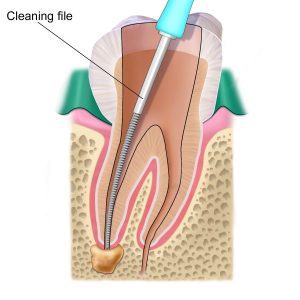A root canal is a procedure we use to remove diseased pulp tissue from the inside of your tooth. It is usually the preferred treatment when a tooth’s nerve becomes infected (abscessed) due to deep decay, trauma, or old crowns or fillings. During a root canal, we hollow out and clean the pulp chamber and part of the root that has pulp. The most common alternative to a root canal is an extraction with an implant or bridge. A root canal will preserve your original tooth whereas an extraction and replacement restores your tooth with a custom fixture. Although the cost of a root canal and crown are expensive, it is usually allot less expensive than an implant or bridge.
We’ll first use a local anesthetic to numb the area around your tooth. Once the dentist confirms you are numb, we begin by making a small hole in your tooth to access its pulp chamber and roots. The infected tissues are then cleaned out with tools called cleaning files. After all of the diseased or damaged tissue is cleaned, we fill the hollowed area with a plant-based filling material, gutta-percha, and cap your tooth with a composite filling.
In most cases, a crown to protect your tooth and restore your bite is the next step after your root canal. During the same visit, we will prep your tooth for the crown, take an impression, and make you a temporary to wear until the lab has made your crown. Once we’ve received your crown from the lab, we will schedule an appointment to bond it in place.

To reduce soreness, care should be taken to eat a softer diet during the first few days after your root canal. If you are also receiving a crown, please read ‘Eating and chewing’ on the crowns and bridges page.
Root canal therapy is about 95% effective in restoring your tooth back to normal function. However, mild discomfort occasionally lingers for a few weeks before your tooth feels normal. If you are also receiving a crown, please read ‘Soreness and sensitivity’ on the crowns and bridges page. If soreness does not improve within a few weeks, please contact our office.
After your final restoration is placed, regular oral hygiene is sufficient.



